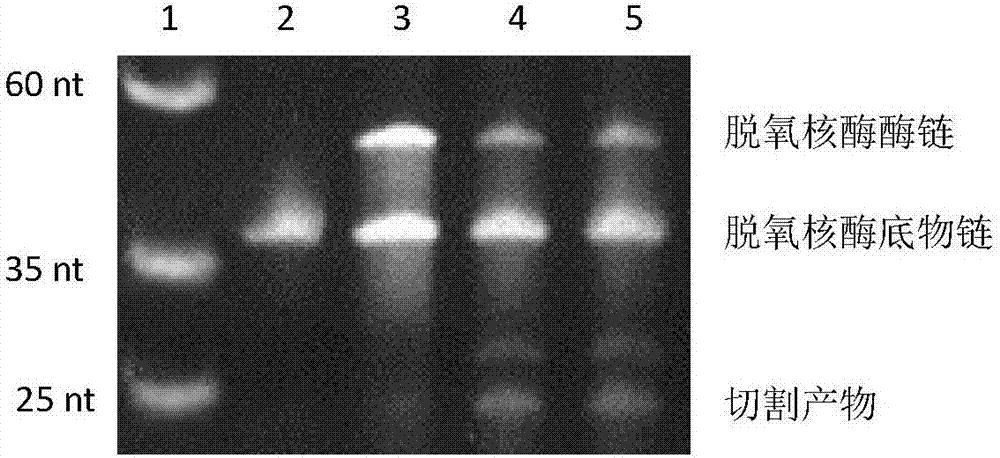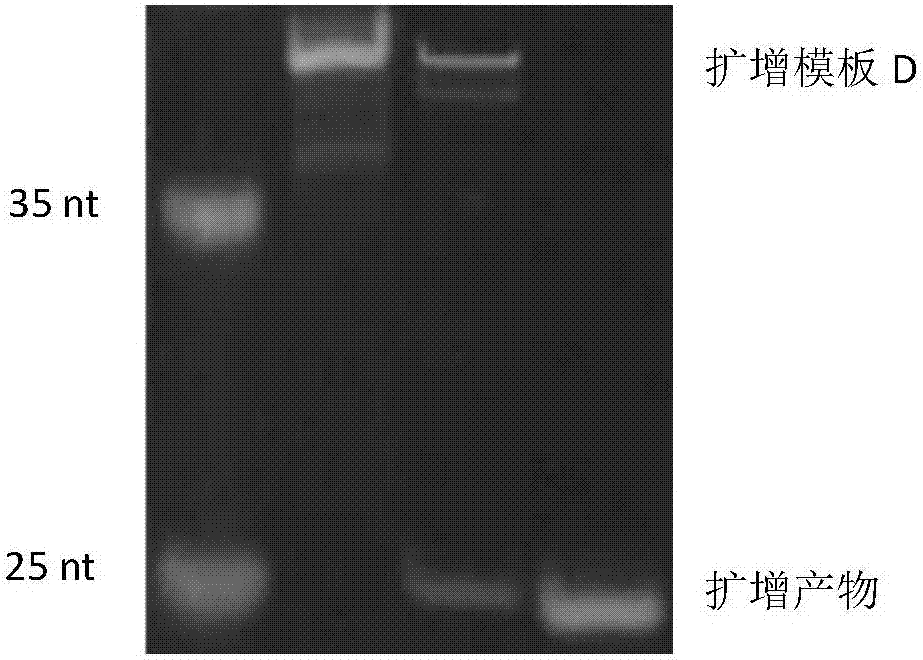Chromium-based functional nucleic acid sensor and application thereof
A functional nucleic acid and sensor technology, applied in genetic engineering, microbial determination/inspection, analysis by chemical reaction of materials, etc., can solve the problems of low reliability and practicability, achieve low cost, high specificity, Effects of high specificity and sensitivity
- Summary
- Abstract
- Description
- Claims
- Application Information
AI Technical Summary
Benefits of technology
Problems solved by technology
Method used
Image
Examples
Embodiment 1
[0064] Embodiment 1: The construction method of the sensor based on the functional nucleic acid of chromium
[0065] 1. Experimental materials
[0066] Morpholineethanesulfonic Acid Monohydrate (MES), Potassium Chloride, Sodium Chloride, Magnesium Chloride, Potassium Hydrogen Phosphate, Disodium EDTA, Sulfuric Acid, Tetramethylbenzidine, Hemin, Chromium Chloride, Urea, Nt.BstNBI nick endonuclease, Bst DNA polymerase, etc.
[0067] 2. Sequence design
[0068] Design and synthesize chromium ion DNAzyme substrate chain, DNAzyme enzyme chain and amplification template. In the amplification template, GACTC is the Nt.BstNBI nicking endonuclease recognition sequence, and the first four base pairs of the sequence (between C and A) are the synthetic strand cutting sites. The sequence of TTGGGGGG at the end of the DNAzyme substrate chain is added to increase the Tm value of binding to the amplified template; the chromium ion cutting site is after the rA of the DNAzyme substrate chain...
Embodiment 2
[0088] Embodiment 2: the detection of chromium ion
[0089] The detection of chromium ion concentration, the specific steps are as follows:
[0090] (1) Prepare OD 450 Standard curve with the concentration of chromium ion
[0091] Using the construction method of 3 in Example 1, the chromium ion solutions to be tested are chromium chloride solutions of different concentrations (1M NaCl is the dissolution environment), and the chromium chloride concentrations are 0 μM, 0.01 μM, 0.025 μM, 0.05 μM and 0.08 μM, and prepared OD 450 The standard curve with the concentration of chromium ion ( image 3 ), the standard curve is y=3.5406x+0.0344, R 2 = 0.9823.
[0092](2) in the present embodiment, the chromium ion solution to be measured is a chromium chloride solution (NaCl is a dissolution environment)
[0093] Adopt the construction method of 3 in embodiment 1, microplate reader measures the OD of chromium ion solution to be measured 450 , into the standard curve y=3.5406x+0....
Embodiment 3
[0096] Embodiment 3: A kind of test kit that detects chromium ion
[0097] A kit for detecting chromium ions, comprising a chromium ion deoxyribozyme system, an isothermal amplification system and a display system;
[0098] Chromium ion deoxyribozyme system includes substrate chain, enzyme chain, buffer, chromium ion standard solution and stop solution;
[0099] The isothermal amplification system includes amplification template, dNTPs, ultrapure water, Bst DNA polymerase, polymerase reaction buffer solution, Nt.BstNBI nicking endonuclease and nicking endonuclease reaction buffer solution;
[0100] The display system includes: hemin, enzyme activity buffer, TMB chromogen and 2MH 2 SO 4 .
[0101] The sequence (5'-3') of the DNAzyme substrate chain is: GTCACGAGTCACTATrAGGAAGATGGCGAAATTGGGGGG;
[0102] The sequence (5'-3') of the deoxyribozyme enzyme chain is: CAGTGCTCAGTGATATTGCTCATTTTTGAGCGTGGGTGGAAACTGGATACCGCTTT;
[0103] The sequence (5'-3') of the amplified template i...
PUM
 Login to View More
Login to View More Abstract
Description
Claims
Application Information
 Login to View More
Login to View More - R&D
- Intellectual Property
- Life Sciences
- Materials
- Tech Scout
- Unparalleled Data Quality
- Higher Quality Content
- 60% Fewer Hallucinations
Browse by: Latest US Patents, China's latest patents, Technical Efficacy Thesaurus, Application Domain, Technology Topic, Popular Technical Reports.
© 2025 PatSnap. All rights reserved.Legal|Privacy policy|Modern Slavery Act Transparency Statement|Sitemap|About US| Contact US: help@patsnap.com



